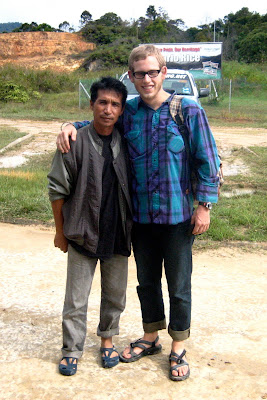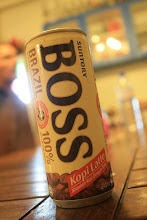
Border patrol.

What'r you lookin at?
Over the course of six days, my guide and I walked two days in Malaysia, cross into Indonesia on the third day, walk for two days, and on the sixth day cross back into Malaysia. To my unfamiliar eyes, Indonesia did not seem at all different with the exception of the occasional flag. My guide told me Indonesian and Malay are very similar languages, so the people can communicate very easily. I think all these similarities speak to the history of this region. Although it spreads across the border of two different countries, the villages Kelabit Highlands are filled with relatives.

Helo!
Walking through the small villages of the Highlands, it is amazing to see the simplicity of life. It seems no one has a 9-5 work schedule-most people are self employed. Rice is the major export from the region, and the people are very proud of their product. Though this region may seem impoverished to a first-worlder, the people here live rich lives of simplicity. Instead of the PC Room, the children play with each other, and find entertainment in the simplest objects (as you can see with the tire). Imagine their surprise when they see a sunburned white man walk by their house...

Hard work.
As mentioned the rice-nasi-is a staple and main export for the Kelabit people. It's hard to find someone that doesn't own a rice padi somewhere. It is amazing to watch the process of harvesting the rice and preparing the padi for the next crop. There are no tractors or machines, everything is done by hand and machete. A man asked me why the English language has only one word for rice. I couldn't give him a very satisfying answer. In Malay, there is a word for rice when it's growing in the padi, a word for it when it's dry and ready to cook, and a word for it when it's on your plate.

Turn that one.
For teenagers, motor bikes in the highlands are the equivalent to cars in the States. In fact, the bikes are a source of income for teenagers. Since most airports in the highlands are not accessible by 4x4, supplies and people are ridden in on the back of these motor bikes. It's very impressive when you see the amount of building materials they didn't harvest from the jungle. Tin roofing, re-bar, cement, electrical materials, computers, etc. When not used for cargo, the kids fly around on them to impress their friends-of course they don't wear helmets.

Shreddin.

LTD.
I took many photos while walking through the jungle, but in the thick vegetation, I had a difficult time capturing a good perspective of the canopy overhead. This photo-I think-does the most justice to the sheer height of these trees. Being a native Oregonian, I have seen some big trees and a few thick forests. What I haven't seen is a tree so straight and so tall as many of these. The only vegetation on a particular species is at the canopy, so the rest of the tree is just a big, tall, smooth trunk.

Blood brothers.




No comments:
Post a Comment